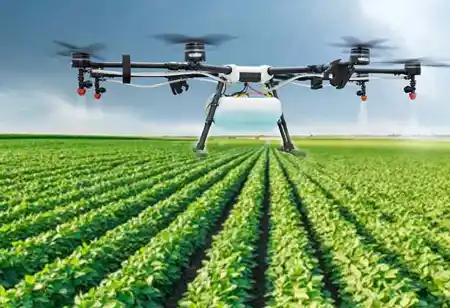Thank you for Subscribing to Agri Business Review Weekly Brief
Exploring the Vitality of Seed Treatment in Agriculture and Ensuring Food Safety
Seed treatment is a crucial practice that entails applying fungicides, insecticides, or a combination of both to seeds.

By
Agri Business Review | Wednesday, June 21, 2023
Stay ahead of the industry with exclusive feature stories on the top companies, expert insights and the latest news delivered straight to your inbox. Subscribe today.
Seed treatment protects seeds and seedlings from diseases, pests, and environmental conditions, improving germination rates and crop productivity while supporting sustainable agriculture.
FREMONT, CA: Seed treatment is a crucial practice that entails applying fungicides, insecticides, or a combination of both to seeds. The main objective is to disinfect seeds, eradicate pathogenic organisms present in the seeds or soil, and eliminate storage insects. Furthermore, seed treatment involves exposing the seeds to solar energy. This comprehensive overview explores the importance of seed treatment, its efficacy in preventing diseases, protecting against seed rot and blights, enhancing germination, safeguarding against storage insects and pests, and the different available methods for seed treatment.
Seed treatment plays a crucial role in safeguarding seeds and seedlings from diseases and insect infestations starting from the moment of planting. The presence of numerous pathogens and insects that can harm or destroy seeds and seedlings before they reach maturity poses a substantial risk to crop productivity and yield. Effective seed treatment effectively addresses these concerns and provides the following advantages:
Disease Prevention: Seed treatment is a highly effective method for preventing the spread of both systematic and non-systematic plant diseases. It effectively controls systematic diseases such as wheat smut, barley helminthosporium blight, as well as loose and covered smut of ores. Moreover, it successfully manages non-systematic diseases caused by infections occurring during harvest or storage, such as fusarium blight in barley, oats, rice, and sorghum.
Protection against Seed Rot and Seedling Blights: The seed treatment forms a protective coating around the seeds, serving as a barrier against seed-borne and soil-borne organisms. This protective layer helps prevent seed rot and seedling blights, ensuring the successful emergence and healthy development of seedlings.
Improvement in Germination: Seed treatment enhances germination rates by effectively controlling surface moulds and other microorganisms. While these microorganisms may not be pathogenic, they can still infect seeds during humid harvesting and storage conditions. By managing their presence, seed treatment improves germination, resulting in strong seedling establishment.
Protection from Storage Insects and Pests: Seed treatment serves as a vital defence against storage insects and pests. However, to ensure comprehensive protection, it is necessary to treat seeds with suitable insecticides.
Conditions Requiring Seed Treatment:
Several conditions necessitate the implementation of seed treatment to maximise seed viability and protect against potential risks. These conditions include:
Injured Seeds: Seeds are susceptible to mechanical injuries during threshing, drying, or processing. Any damage to the seed coat creates an ideal entry point for fungi or pests, that results in seed death or reduced viability. Treating injured seeds mitigates these risks.
Diseased Seeds: Seeds can become infected by disease organisms during harvest, processing, or storage. Treating such seeds effectively eliminates or reduces the pathogens present, promoting healthy seedling development.
Undesirable Soil Conditions: Seeds are occasionally planted in unfavourable soil conditions, such as damp or cold soils, which facilitate the growth of certain spores. Treating seeds in such instances prevents seed infection and damage, ensuring successful germination.
Disease-Free Seed: Seed treatment offers a reliable defence against diseases and soil-borne organisms, safeguarding weak seeds and facilitating their successful germination. By treating disease-free seeds, farmers can ensure healthy seedling development and crop growth.
Types of Seed Treatment:
Various methods and approaches are employed for seed treatment, depending on specific requirements and desired outcomes. The following are the different types of seed treatment:
Physical Seed Treatment: This method encompasses the utilisation of mechanical or physical techniques on seeds. It includes processes such as scarification (scratching the seed coat), stratification (exposing seeds to cold temperatures), or hot water treatment. These physical treatments effectively break seed dormancy, enhance germination, and stimulate specific responses in seeds.
Chemical Seed Treatment: Chemical seed treatment entails the targeted application of specific chemicals to seeds. This approach is highly effective in controlling diseases and pests, and improving germination and seed vigor. Fungicides, insecticides, and seed disinfectants are among the commonly used chemicals in seed treatment.
Biological Seed Treatment: Biological seed treatment involves the application of beneficial microorganisms, such as bacteria or fungi, to seeds. These microorganisms play a pivotal role in promoting plant growth, protecting against diseases, and enhancing nutrient availability. Biological seed treatment is commonly favoured in organic farming practices.
Nutritional Seed Treatment: Nutritional seed treatment encompasses the application of vital nutrients or growth-promoting substances to seeds. This treatment effectively boosts the nutrient content of seeds and enhances seedling vigour, resulting in healthier plant development.
Genetic Seed Treatment: Genetic techniques are utilized to enhance desirable traits in seeds, including disease and pest resistance, as well as tolerance to environmental stresses. This approach involves genetic modification or selection to develop seed varieties with improved characteristics.
Environmental Seed Treatment: Environmental seed treatment involves subjecting seeds to specific conditions, such as controlled temperature or humidity levels, to stimulate germination or break seed dormancy. By providing these favourable environmental conditions, this treatment method ensures optimal seed germination and promotes early growth.
Seed treatment is a critical practice that plays a pivotal role in safeguarding seeds and seedlings from diseases, pests, and adverse environmental conditions. It provides a multitude of advantages, including disease prevention, protection against seed rot and blights, improved germination rates, and defence against storage insects and pests. With various types of seed treatment methods at their disposal, farmers and growers can select the most suitable approach according to their specific needs and objectives. By prioritizing seed treatment, farmers can enhance crop productivity and contribute to sustainable agricultural practices.





